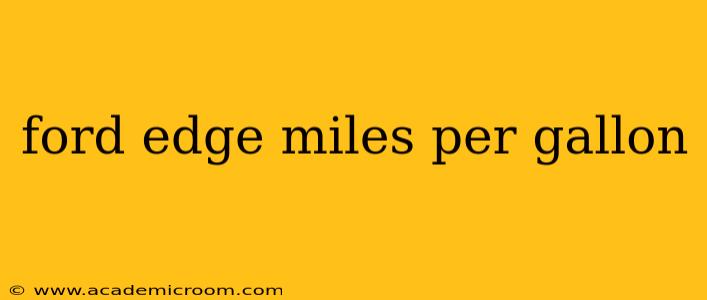The Ford Edge, a popular mid-size SUV, offers a range of engine options, each impacting its miles per gallon (MPG) significantly. Understanding the factors influencing fuel economy is crucial for prospective buyers and current owners alike. This guide delves into the MPG of various Ford Edge models, exploring factors affecting fuel efficiency and providing tips for maximizing your gas mileage.
What is the average MPG for a Ford Edge?
The average MPG for a Ford Edge varies considerably depending on the model year, engine type, and driving conditions. Generally, you can expect EPA estimates ranging from the low 20s to the mid-20s in combined city/highway driving for many models. However, achieving these numbers often depends on individual driving habits and the vehicle's condition. It's crucial to consult the EPA's FuelEconomy.gov website for precise figures based on the specific year and trim level of your Ford Edge.
How many MPG does a 2023 Ford Edge get?
The 2023 Ford Edge offers a single engine option – a 2.0L EcoBoost I4 engine. The EPA estimates for this engine typically fall in the range of 21 MPG city and 28 MPG highway, resulting in a combined MPG around 24. Again, real-world mileage may vary.
What affects Ford Edge gas mileage?
Several factors significantly impact the fuel economy of your Ford Edge:
- Driving Habits: Aggressive acceleration, frequent braking, and excessive idling all reduce fuel efficiency. Smooth, consistent driving is key to maximizing MPG.
- Terrain: Driving uphill or in stop-and-go traffic consumes more fuel than driving on level roads at a steady speed.
- Vehicle Load: Carrying extra weight reduces MPG, as the engine has to work harder.
- Tire Pressure: Properly inflated tires improve fuel efficiency by reducing rolling resistance. Underinflated tires increase friction and decrease MPG.
- Engine Size and Type: Larger engines generally consume more fuel than smaller ones. The type of engine (e.g., gasoline, hybrid) also plays a significant role.
- Regular Maintenance: Keeping your Ford Edge in top condition, with timely oil changes and other maintenance, contributes to optimal engine performance and fuel economy.
- Climate Control: Using the air conditioning can slightly decrease MPG.
How can I improve my Ford Edge's MPG?
Improving your Ford Edge's fuel economy is achievable through several strategies:
- Adopt a smoother driving style: Avoid harsh acceleration and braking. Anticipate traffic and maintain a consistent speed whenever possible.
- Maintain proper tire pressure: Regularly check and inflate your tires to the recommended pressure listed in your owner's manual.
- Reduce vehicle weight: Remove unnecessary items from your vehicle.
- Use cruise control on highways: Maintaining a steady speed helps optimize fuel efficiency.
- Keep your vehicle well-maintained: Ensure regular oil changes and address any mechanical issues promptly.
- Consider fuel-efficient driving techniques: Plan your routes to avoid stop-and-go traffic, and try to drive at optimal speeds for fuel efficiency.
Does the Ford Edge have different MPG depending on the trim level?
While the base engine remains largely consistent across trim levels, subtle differences in weight and optional equipment (like larger wheels) might slightly affect the MPG. However, these variations are typically minimal. The EPA estimates will provide the most accurate comparison between trim levels for a given model year. Always check the EPA's FuelEconomy.gov website for specific details.
This guide provides a comprehensive overview of Ford Edge MPG. Remember to consult the official EPA website and your owner's manual for the most accurate and up-to-date fuel economy information specific to your Ford Edge model. Driving habits and vehicle maintenance play a vital role in achieving optimal gas mileage.
